Community Colleges & Innovative Partnerships
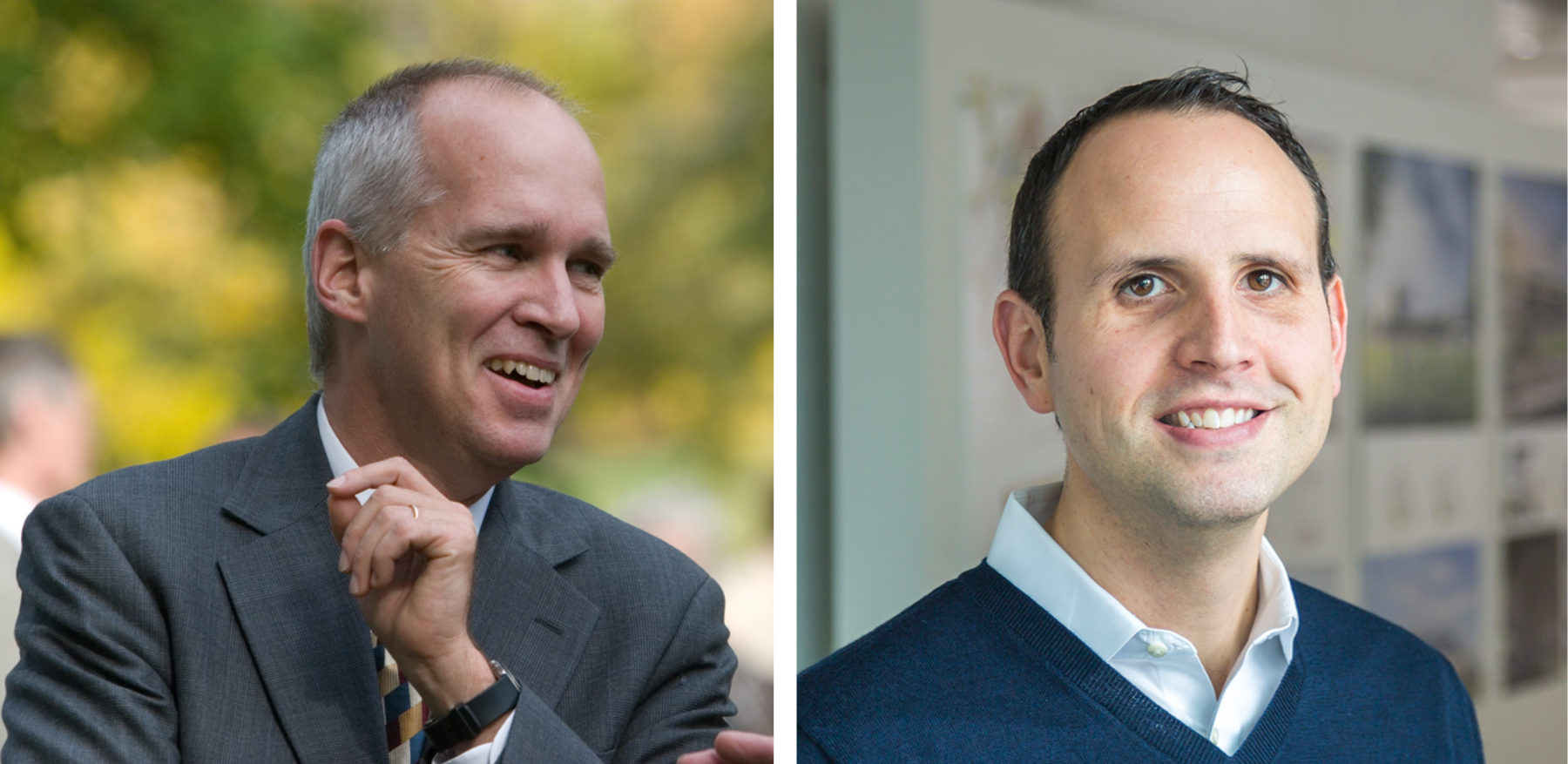
 Sasaki
Sasaki

The following piece, written by Sasaki Principals Bryan Irwin, AIA, LEED AP [pictured left], and Tyler Patrick, AICP, [pictured right] originally appeared in the October-December issue of Planning for Higher Education, published by the Society for College and University Planning (SCUP).
Partnerships are all the rage at colleges and universities across the country. The most frequent use of the word as of late has been in reference to public-private partnerships (P3)—a funding model that relies on the skills and assets of each sector (public and private) to deliver a project. But P3 isn’t the whole picture. Partnership opportunities are broad and plentiful—only limited by an institution’s imagination. No group knows the power of innovative partnerships better than community colleges.
For community colleges, partnering with institutional, civic, and corporate organizations isn’t just one additional avenue towards achieving goals—these partnerships are an inherent and indisputable part of their core mission. We have worked with community colleges across the country to recognize, develop, and refine innovative partnerships that benefit the school’s mission, student experience, and larger civic and industry needs.
The very origin of community colleges is, in fact, one of partnership with their communities. Sinclair Community College, established in 1887 and regarded as the nation’s first community college, was founded in conjunction with the Dayton, Ohio YMCA to teach unemployed men the skills necessary to find employment. Sinclair’s growth from small, make-shift classrooms in houses and basements to its current 20-acre campus mirrors the growth of Dayton as an economic and industrial hub. Sinclair established the notion of community colleges as tailoring their programs to the specific needs of their region’s economy—a notion espoused by their credo: “Find the need and endeavor to meet it.” This ability to quickly respond to developments in the local workforce has turned into an inseparable, intrinsic tenet of America’s 1,100 community colleges. Today, these schools play an integral role in the academic landscape, offering degrees and certificates in some of the most crucial skillsets that our regional and national economies need.
This dyed-in-the-wool approach to partnering with the communities in which they are located has led to innumerable synergistic opportunities. Often anchored by two-year workforce-driven degree programs that feed directly into the surrounding market, they are able to innovate and evolve with the local job market at a rapid pace. Through our master planning and architecture work, we have collaborated with several community colleges to help them leverage existing relationships and develop innovative new approaches that put them at the head of the pack in terms of preparing students for tomorrow’s economy. From providing industry-specific learning environments and celebrating synergies with host communities to serving as a pipeline from K-12 through advanced degrees and serving underserved areas, all can be achieved or furthered through mutually-beneficial partnerships—and each is increasingly central to the 21st century educational landscape.
In this article, we share some of our experiences in working with schools to further their academic missions through partnerships. In profiling the approaches and successes of these schools, we hope to offer insight and inspiration. These strategies are not limited to any one kind of institution, and we encourage readers to think about the possible synergies waiting to be leveraged in their communities to support their institutional goals.
Facilities such as health simulation labs and manufacturing workshops with up-to-date machinery and interfaces are expensive to build and maintain, but are essential in fully engaging many students in their field of studies. Many local industries are willing to subsidize or cover the cost of high-tech experiential environments that correspond to the specifics of their industry. This enables the school’s students to graduate with the skills and knowledge they need to transition directly into employment with significantly less on-the-job training. These partnerships ensure a steady stream of job-ready candidates for the industry, bolster graduation rates, and increase the area’s workforce productivity. It’s a great bargain—for students, local industry, and schools’ budgets—and community colleges across the country are leveraging these possible synergies when they can.
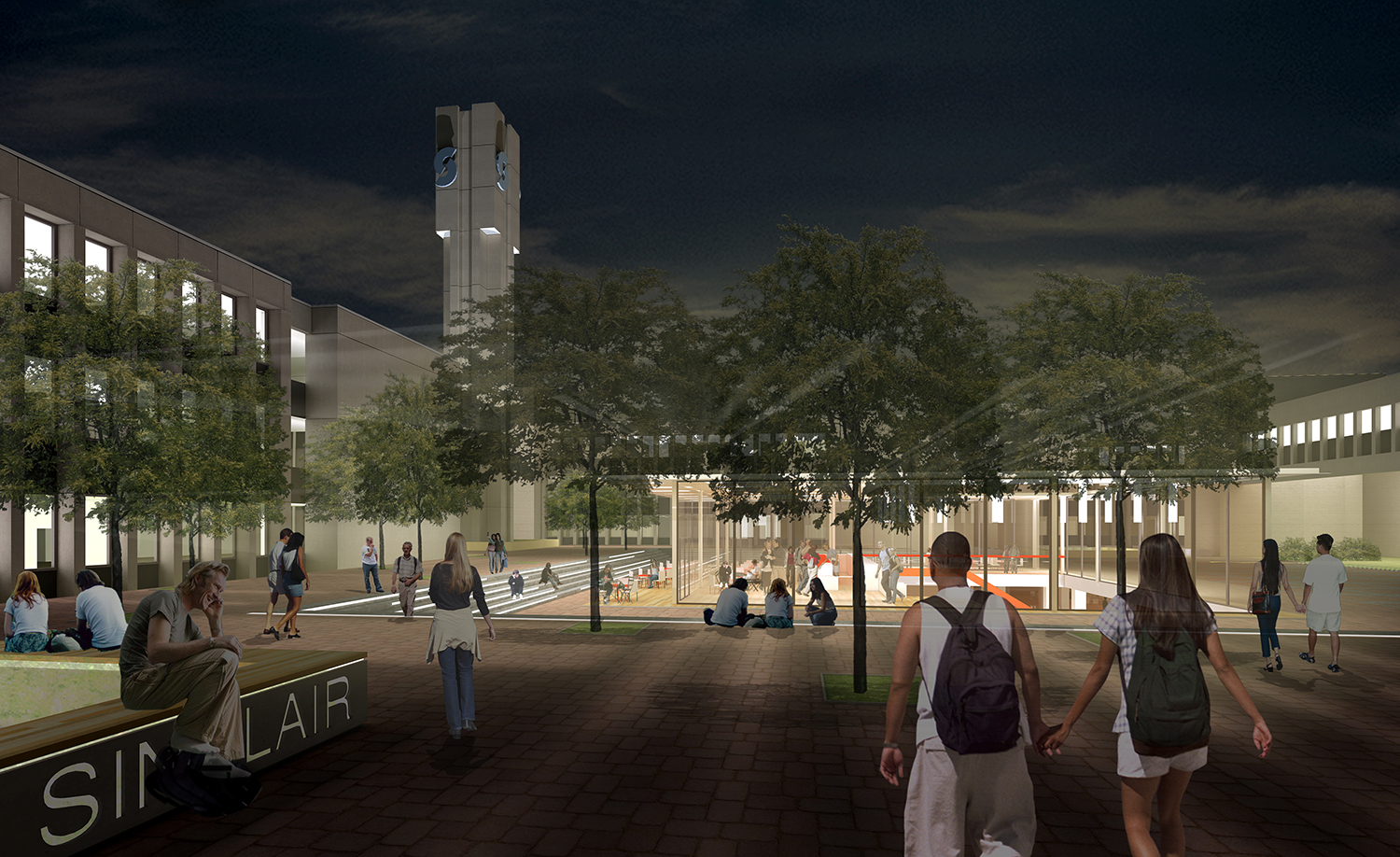
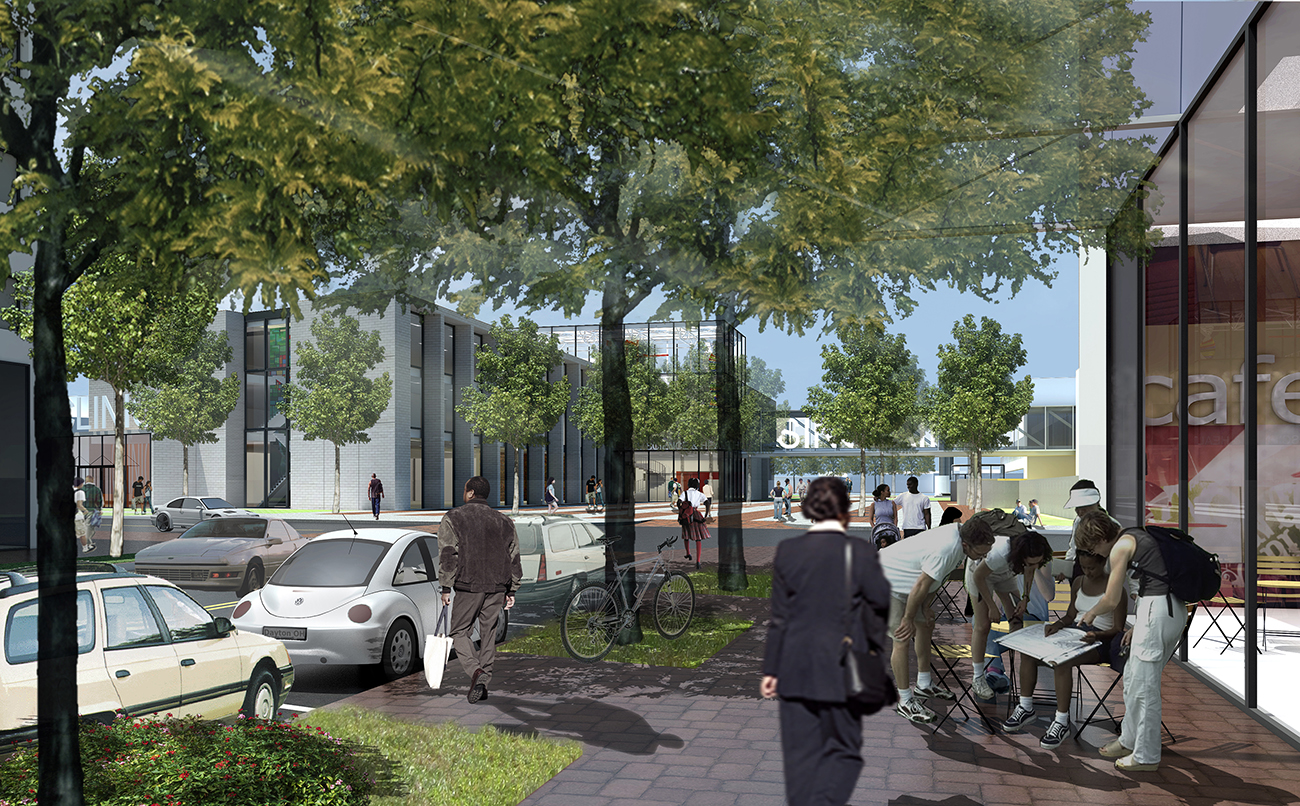
See and Be Seen: Located in the heart of Dayton, Sinclair Community College blurs the line between campus and community
For our 2013 master plan for Sinclair Community College, maximizing these industry partnerships was a central goal. Dayton, Sinclair’s host community, had been hit hard by the recession. Sinclair, in line with their credo, “endeavored to meet” the city’s need for a skilled workforce that would spearhead the area’s recovering economy. With this in mind, understanding where the region’s industry had been and where it’s going was very important for Sinclair. Home to the Wright Brothers and neighbored by Wright-Patterson Air Force Base, Dayton has played a central role in the aerospace industry since its humble beginnings early last century. To gauge the current context, we incorporated industry leaders into the planning process from the beginning through a series of focus group meetings. Their input proved invaluable for shaping Sinclair’s programmatic evolutions for the next several years by helping the project team understand what’s next for the industry. Aligning their thriving academic programs with these new developments in industry will continue to have a major positive impact on the region’s development and economic recovery by positioning the school as a feeder for the city’s many aerospace-related companies.
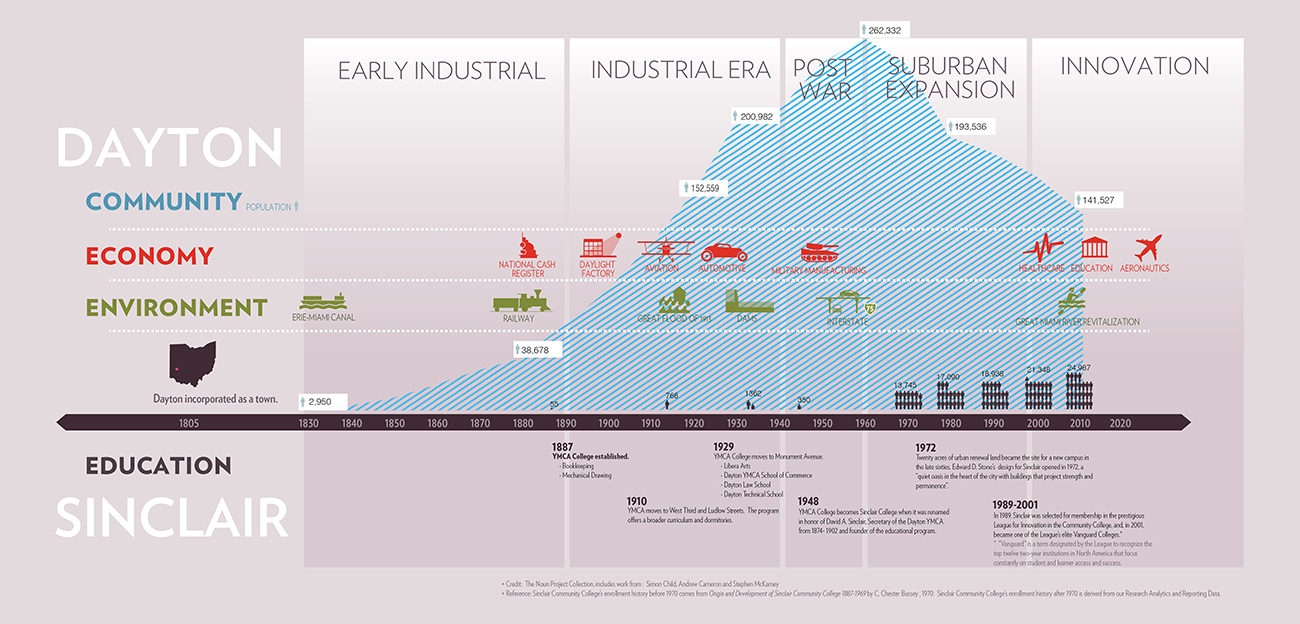
No Community College is an Island: Sinclair’s success is intertwined with the economic context of Dayton, OH
In addition to industry partnerships, synergies with community organizations can also capture significant programmatic and financial benefits for both schools and communities. Founded in 1965, Massachusetts’ North Shore Community College (NSCC) has played an integral role in the economic and educational landscape of the state, offering its students degrees and certificates in some of the most crucial skillsets that Massachusetts and national economies need. Completed this summer, our master plans lay the path for future development on these physical campuses, and illustrate avenues for embracing key partnerships that expand and improve their service to their 16,000 students and host communities.
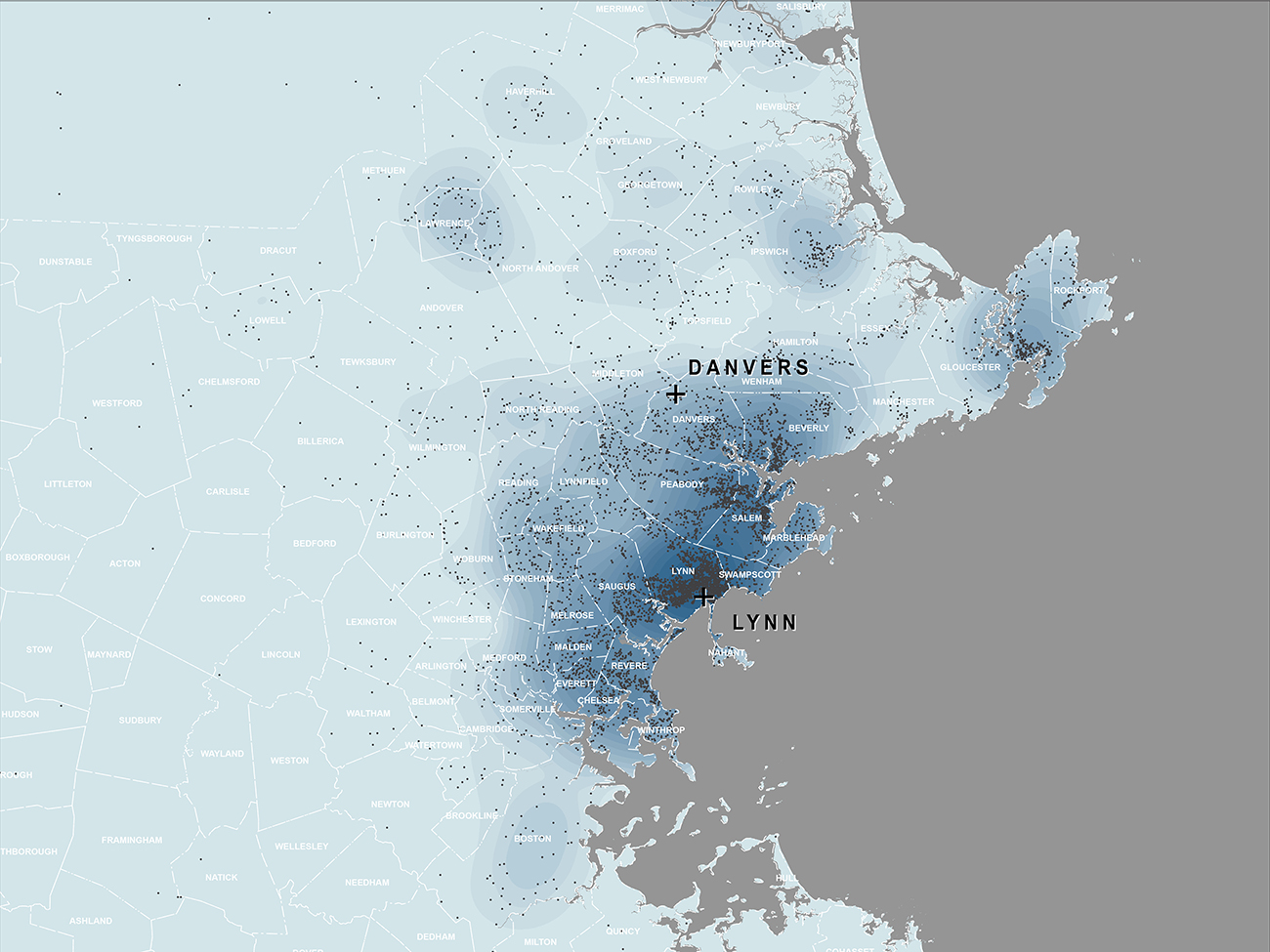
Demographic map of the North Shore region, demonstrating the cities and towns from which the Lynn and Danvers campuses draw students, faculty, and staff
In developing the master plan for NSCC’s Lynn campus, we looked at these synergistic opportunities and were able to propose several innovative shared-space arrangements:
Partnering with a local youth recreation organization and a radio station creates in-roads into the community while providing students expanded opportunities for recreation and experiential learning. A link between a local museum and arts organization represents another symbiosis. As outlined in the master plan’s recommendations, sharing use of the arts organization’s existing visual and performing arts facilities would provide students access and would open up options for co-hosted arts events for the betterment of the whole community. These smart spatial usages offer financial benefits to each party through limiting the duplication of expensive facilities. Reciprocally, NSCC offers space for community events on its campuses, such as meeting rooms and outdoor recreational amenities.
Organizational partnerships such as these should also be complemented by spatial and design recommendations that encourage increased physical interaction between “town” and “gown.” For the master plan, we encouraged NSCC to celebrate Broad Street—the main seam between their Lynn campus and the community—by relocating the campus bookstore and the culinary arts and cosmetology program spaces to this prominent locale. Placing these service-based programs at the campus’ “front door” promotes community integration, access, and use, perpetuating a symbiotic ethos of community and pride.
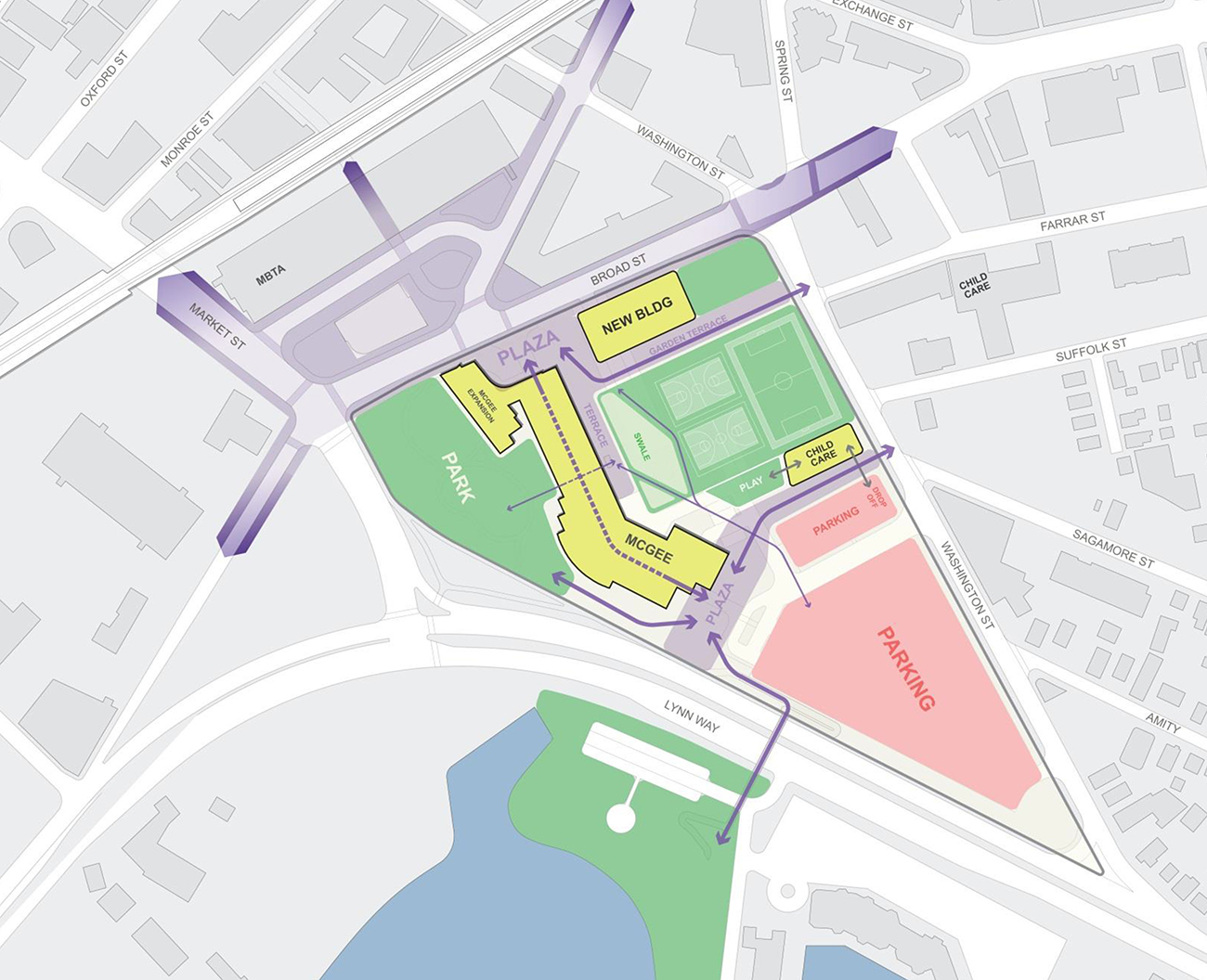
A two-way Street: Relocating service-based programs to the campus’ “front door” encourages town-gown interaction
Another strong way that community colleges can create in-roads into their neighboring communities and provide their current and future students with expanded opportunity is through partnering with area school districts and universities. Many community colleges have established partnerships with universities, and it’s a great system; such partnerships create a pipeline to higher education for students not prepared academically, financially, or otherwise for a four-year school. Pairing these existing relationships with awareness programs throughout an area’s K-12 schools positions community colleges as not only a strong generator of workforce skillsets, but as a stepping stone to higher education for a greater student population. Beginning these conversations early helps parents and children understand the educational opportunities that are available.
For example, central to the master plan for the Lynn campus of North Shore Community College is leveraging the impact of CommUniverCity—an urban education-workforce development collaboration between NSCC, Salem State University, and the City of Lynn. Established in 2015, CommUniverCity focuses on the education and workforce needs of Lynn, the largest urban center in Essex County. The program uses an outreach and awareness model, coined “birth-to-career,” to create pathways to education for people of all ages. Outreach programs throughout Lynn Public Schools educate children and parents on college options, with a special focus on low-income families and potential first-in-family college graduates. High-schoolers can partake in early and dual enrollment opportunities at NSCC, while NSCC students can transition into select baccalaureate programs at Salem State. NSCC will increase its involvement in CommUniverCity over time through tying its programmatic offerings to workforce demands, such as manufacturing, healthcare, financial services, construction, life sciences, and information technology. Many graduates find employment in the immediate area—completing the “birth-to-career” loop, and directly contributing to the economic productivity of the region.
A 2016 report from the American Association of Community Colleges (AACC) shows that 7.3 million students enrolled for full- or part-time classes at community colleges in the fall of 2014—representing a full 45% of all undergraduate enrolled at that time. Last year, President Obama announced the America’s College Promise, an initiative to make two years of community college free for students who meet a few basic requirements and keep their grades up. Community college has never been more encouraged or accessible to a large swath of the population as it is now, and it’s easy to see the important role that these institutions continue to play in helping the U.S. maintain relevance in the global economy. There is, however, one major hurdle standing between some would-be students and enrollment—location. For institutions with a predominantly commuter student body, many students do not enroll or complete their degrees simply due to the difficulty of getting to campus.
Lorain County Community College (LCCC), in Ohio, took an aggressive head-on approach to this issue. LCCC created a satellite campus to improve access to a previously underserved geographic area of Lorain County. Dubbed the University Center Ridge Campus (UCRC), the “campus” is comprised of a single building. The Sasaki-designed building combines teaching spaces including a health sciences simulation lab, faculty offices, a testing center, and a variety of student services. Distance-learning video labs connect back to the main campus for classes and events. A public transit stop directly in front of the facility and a courtyard/drop-off area for shuttle buses and vans make the campus more accessible. The highly-flexible learning and student support center provides an oasis of learning for area students who were, for reasons of location and transit, previously unable to access quality education and career training.
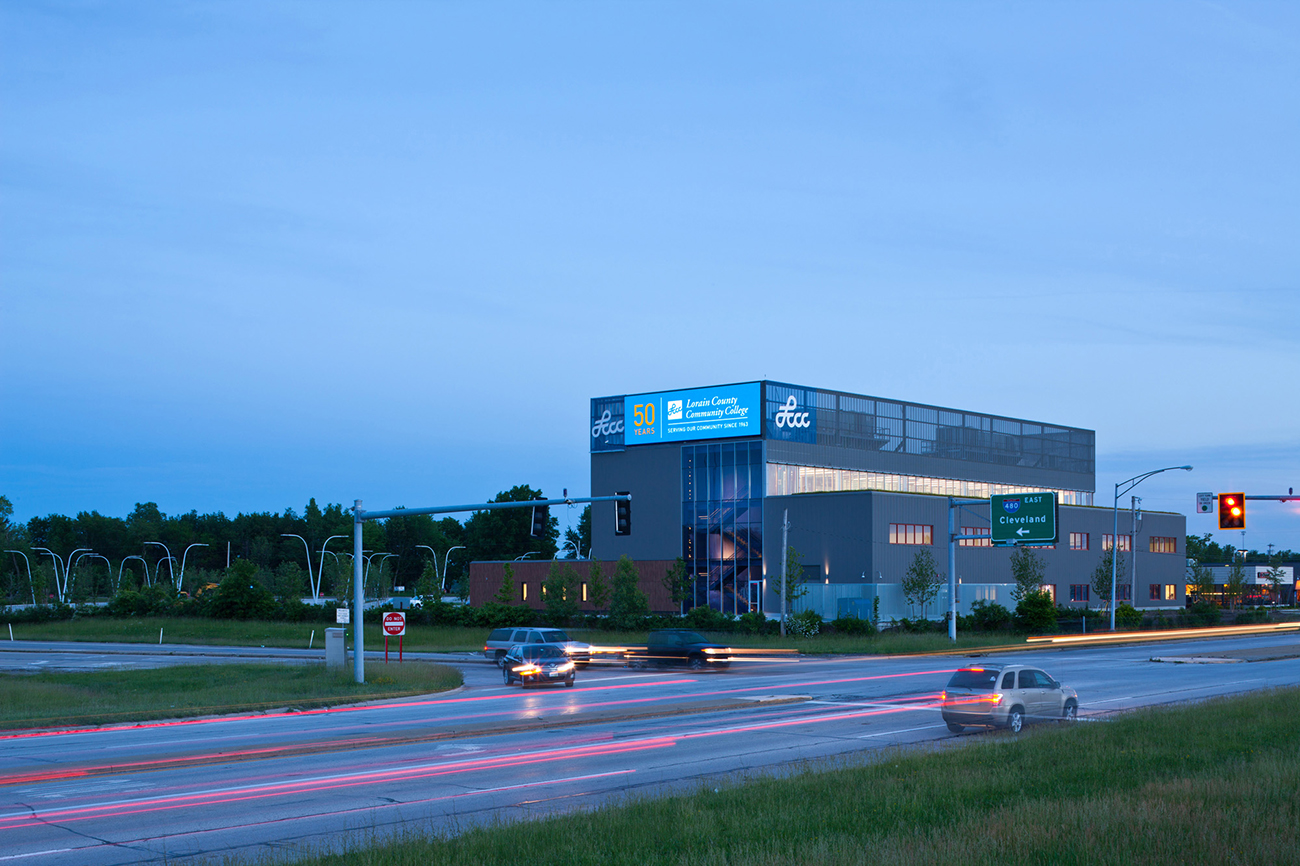
Location, Location, Location: The UCRC building makes school possible for students previously limited by geography and transit options
While it has ties back to LCCC’s main campus, the UCRC operates as a self-sufficient campus. The building’s program spaces and classrooms are organized around a dramatic three story atrium that serves as a community gathering space. To maximize ease-of-access, the site is prominently located along a major interstate highway. The building takes advantage of this location to establish a billboard-like presence to the road, celebrating the existence of an academic institution in this previously underserved area. Students who attend the UCRC are able to attain associate and bachelor degrees in one building—significantly lowering barriers of transit and location for current and future students in the area. Among the UCRC’s academic offerings is a Computer Science and Engineering (CSE) program made possible through a partnership with the University of Toledo—training students in a highly-coveted skillset for the tech sector. An integrated campus bookstore and tutoring spaces round out the experience, providing students with the amenities they need for success.
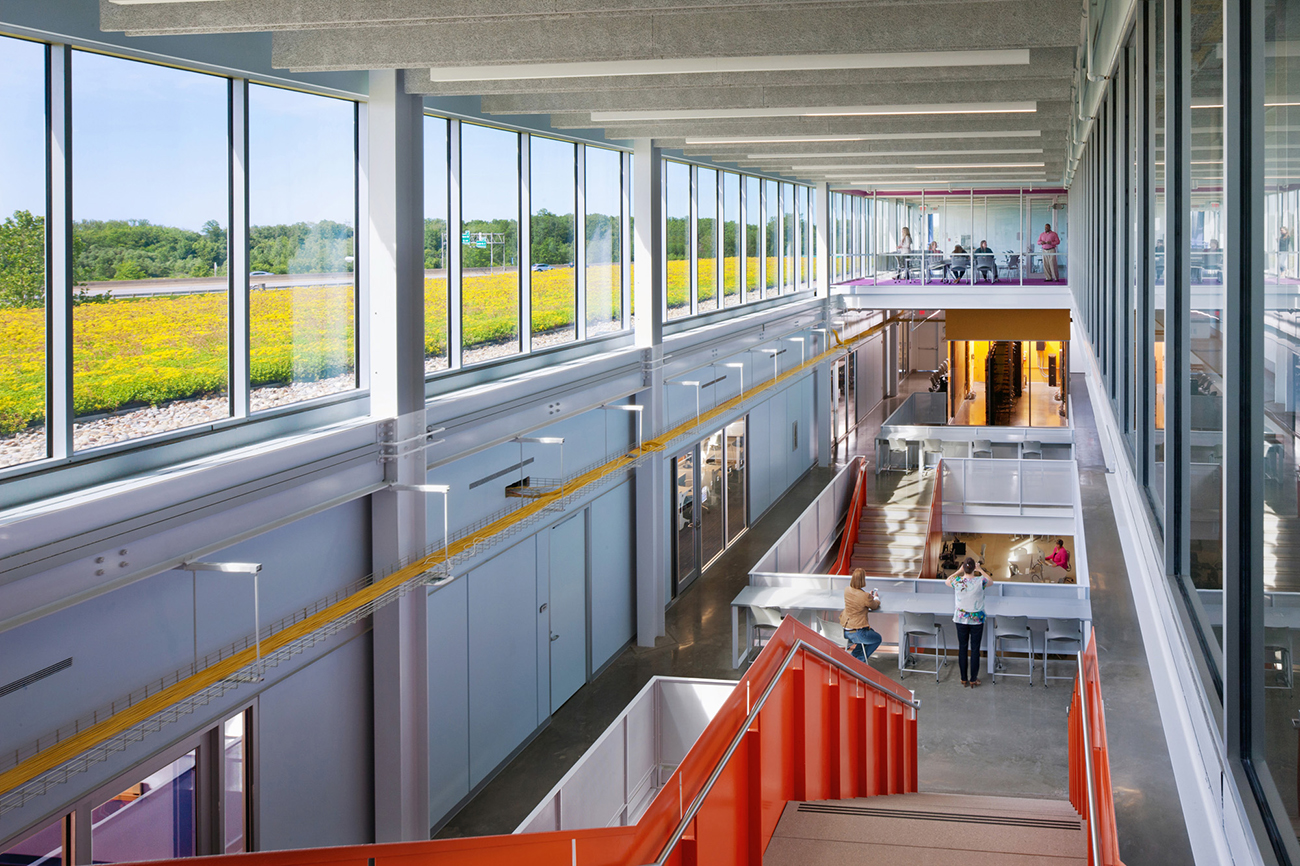
An Oasis of Learning: The UCRC is a one-stop shop for students and also provides amenities to members of the broader community
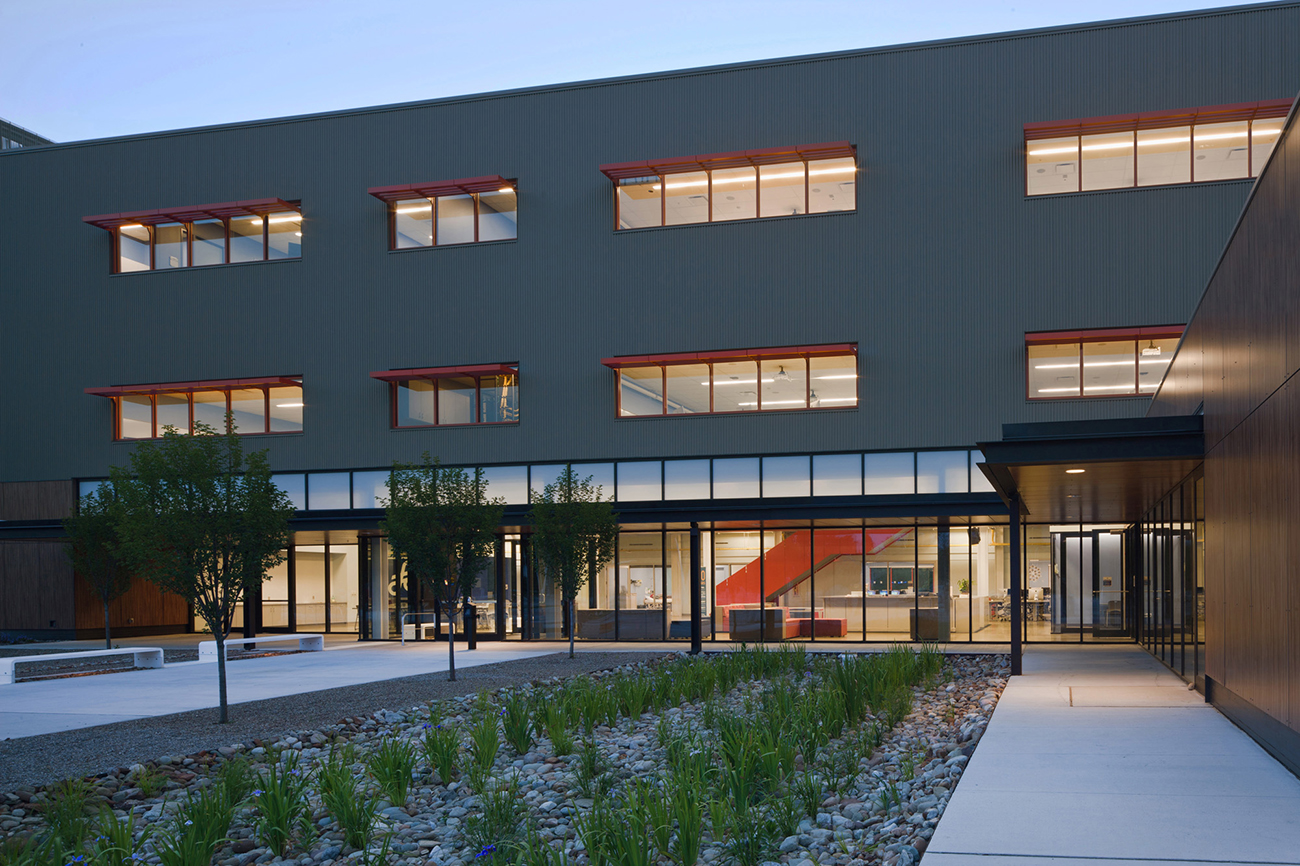
Glass along the ground floor conveys transparency, inviting students and community members alike
The driving purpose of the UCRC is to enable access to students in an otherwise underserved area of Lorain County, but the possibilities don’t stop there. The building offers several community-facing services, such as fingerprinting and background checks for job seekers, and free computer access. Offerings like these realize the full potential of a community college in bringing value not only to enrolled students but to the community at large. The result raises the bar of the entire region. Blurring the lines between student and community member, campus and community, school and work experience have long been core tenets of community colleges, and we are seeing schools embrace new opportunities to do so.
While never static, the landscape of higher education has faced considerable changes in recent times. Rapid advances in tech-driven pedagogical models, decreased funding (or the same amount, just stretched thinner), and pressure to attract and retain students through the “amenities arms race” leave schools financially and organizationally taxed. Over the years, community colleges have pioneered innovative partnerships with outside entities to enhance campus facilities, expand pedagogical paradigms, and strengthen relationships with surrounding communities and traditional four-year colleges. This leaves them well-poised to view today’s challenges as opportunities. Finding financially viable avenues for providing students access to high-tech work environments, for instance, also creates synergies that enable industries to view current students as future employees. Implementing transfer programs to four-year schools attracts new students to the community college and increases retention and graduation rates over the course of their programs at both schools.
The centrality of partnerships to the mission and success of community colleges is not limited to these schools, however. Regardless of who you are—administrator of a private or public college or university, campus planner, architect—there’s plenty to be learned from these schools who have quietly led the way on creative partnerships with their fellow schools, local industries, and communities around them.